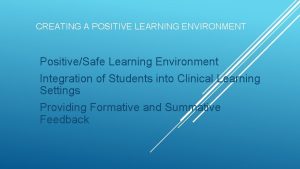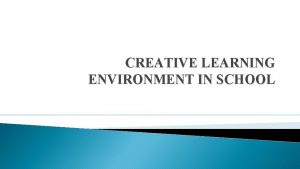Chapter 6 The Design of Learning Environment From













- Slides: 13

Chapter 6: The Design of Learning Environment From: How People Learn: Brain, Mind, Experience, and School Edited by Bransford, Brown, and Cocking Presentation by Andy Plemmons, Tanya Martin, and Bill Frame

Design of Learning Environments • Design • As is underpinned by theory changes so should design. (Bransford, Brown, & Cocking, 1999)

Design as seen through the lens of… � Learner Centered Perspective � Knowledge Centered Perspective � Assessment Centered Perspective � Community Centered Perspective (Bransford, Brown, & Cocking, 1999)

Changes in Education Goals � 1800 s – Writing transformed from note taking to composition � Early 1900 s – Children as products of an education factory � Late 1900 s – Students building on knowledge and improving it � Now – “Student identify and solve problems” and do so throughout their lives (Bransford, Brown, & Cocking, 1999)

Learner-Centered Environments Definition: LCEs “pay careful attention to the knowledge, skills, attitudes, and beliefs that learners bring to the educational setting” LCEs can be fostered through a practice called diagnostic teaching Teachers observe students, question/talk to them, and reflect on the students’ products in order to assess prior knowledge and misconceptions Teachers design instruction to engage students in “cognitive conflict” (creating disequilibria to help students assimilate their new knowledge LCEs also focus on cultural and language sensitivity Students may enter the classroom with different home experiences, cultural values/beliefs, ways of speaking Teachers must be aware of this diversity and design instruction to work with students’ backgrounds and modes of communication To create a learner-centered environment, teachers must understand “that learners construct their own meanings, beginning with the beliefs, understandings, and cultural practices they bring to the classroom” (Bransford, Brown, & Cocking, 1999)

Knowledge-Centered Environments Definition: KCEs recognize that expert ability “requires well-organized bodies of knowledge that support planning and strategic thinking” KCEs help students gain knowledge through understanding and transfer Studying current research can help teachers present information in ways that will help students become knowledgeable (key: depth over breadth) Standards help define what knowledge/competencies students should acquire Learner-centered strategies also help teachers know what to present and how Encouraging metacognition helps students think about their understanding KCEs include a process called progressive formalization, in which “Instructional units encourage students to build on their informal ideas in a gradual but structured manner so that they acquire the concepts and procedures of a discipline” To create a knowledge-centered environment, teachers must educate students “to understand an overall picture that will ensure the development of integrated knowledge structures and information about conditions of applicability”—to “learn their way around” the discipline (Bransford, Brown, & Cocking, 1999)

Assessment Centered Environments � Assessment should provide opportunity for feedback and revision � Formative assessment – in-class feedback on teaching and learning ◦ Example: comments on drafts � Summative learning assessment – measures end-game ◦ Example: standardized tests (Bransford, Brown, & Cocking, 1999)

Formative Assessments and Feedback � Goal: Continuous feedback as part of instruction � Goal: Build an environment where the student begins to self assess � Method: Collaborative groups � Method: Portfolio assessment (Bransford, Brown, & Cocking, 1999)

Community-Centered Environments • Definition: CCEs recognize that “the degree to which environments are community centered is also important for learning. ” This idea of community includes “the classroom. . . , the school. . . , [and] the larger community of homes, businesses, states, the nation, and even the world” • In classrooms and schools, several community-related factors are critical: – – – Social norms of a school/classroom can dictate students’ communication Students’ own cultural norms can also affect how they participate in class Expectations (especially inconsistent ones) can affect students’ learning Grading practices and competition can affect students’ participation/comfort Strong teacher learning communities can positively affect student learning • Links to the larger community are also critical: – – Families’ attitudes, resources, and participation affect students’ learning Extracurricular and community activities can help foster student learning Outside experts and audiences can increase students’ motivation Technology enhances students’ abilities to connect to the broader community (Bransford, Brown, & Cocking, 1999)

Television Children learn from television: ◦ educational vs. entertainment � Television role models affect children’s attitudes: ◦ positive vs. negative (Bransford, Brown, & Cocking, 1999) � � Current research: ◦ Negative effects under the age of 2 (Anderson & Pempek, 2005) ◦ Negative effects of excessive viewing (Hancox, Milne, & Poulton, 2005) ◦ Changes in television content over past 10 years

Importance of Alignment � Learner, knowledge, assessment, and communitycentered environments should be aligned � There needs to be consistency across the school � Schools need systematic ways of tracking the alignment � Schools can explore a variety of tools for tracking such as Renzulli Learning Systems (Bransford, Brown, & Cocking, 1999)

Conclusion �Four perspectives on learning environments: Student centered, Knowledge centered, Assessment centered, Community centered �Alignment is key

References � Anderson, D. R. , & Pempek, T. A. (2005). Television and very young children. American Behavioral Scientist. 48, 505 -522. � Bransford, J. D. , Brown, A. L. , & Cocking, R. R. (Eds. ). (1999). How people learn: Brain, mind, experience, and school. Washington, DC: National Academy of Sciences. � Hancox, R. J. , Milne, B. J. , & Poulton, R. (2005). Association of television viewing during childhood with poor educational achievement. Archives of Pediatrics and Adolescent Medicine. 159, 614 -618.
 Cuadro comparativo de e-learning
Cuadro comparativo de e-learning Financial environment of business
Financial environment of business Hát kết hợp bộ gõ cơ thể
Hát kết hợp bộ gõ cơ thể Lp html
Lp html Bổ thể
Bổ thể Tỉ lệ cơ thể trẻ em
Tỉ lệ cơ thể trẻ em Voi kéo gỗ như thế nào
Voi kéo gỗ như thế nào Glasgow thang điểm
Glasgow thang điểm Hát lên người ơi
Hát lên người ơi Các môn thể thao bắt đầu bằng tiếng đua
Các môn thể thao bắt đầu bằng tiếng đua Thế nào là hệ số cao nhất
Thế nào là hệ số cao nhất Các châu lục và đại dương trên thế giới
Các châu lục và đại dương trên thế giới Cong thức tính động năng
Cong thức tính động năng Trời xanh đây là của chúng ta thể thơ
Trời xanh đây là của chúng ta thể thơ

























